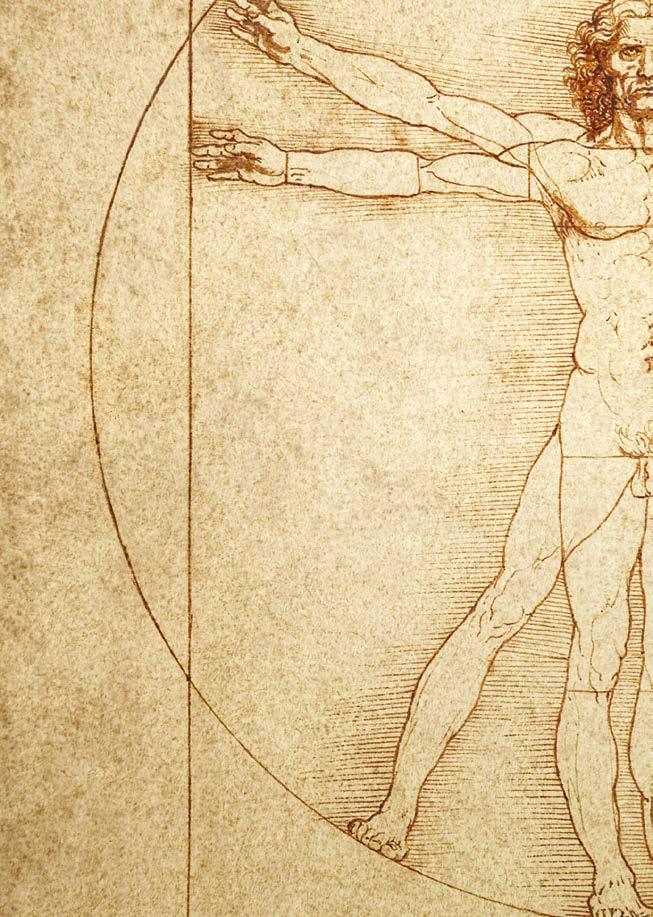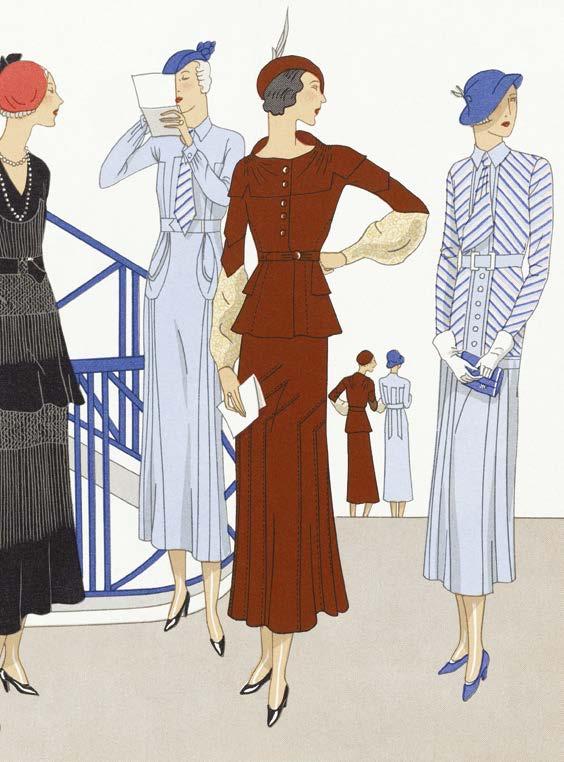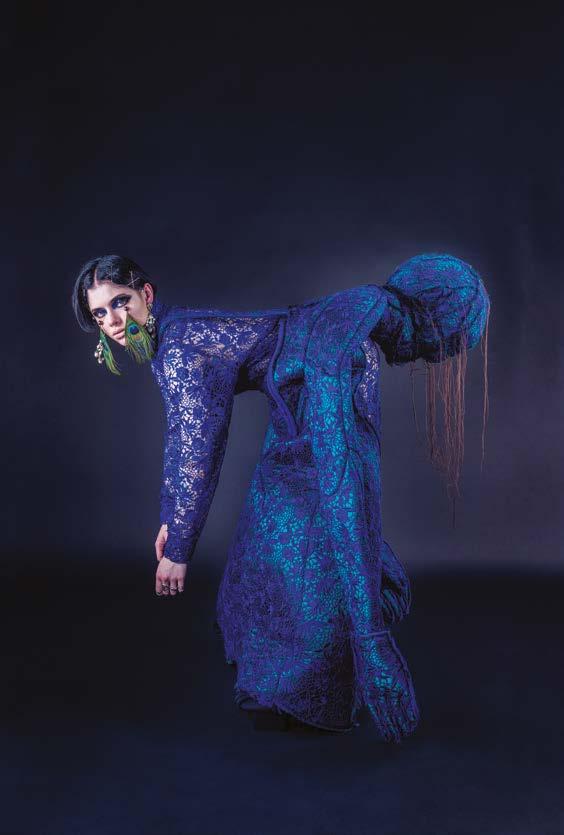
7 minute read
The Incredible Story of Discord in Clothing
The Incredible Story of Discord in Clothing
Symmetry and asymmetry have taken on changing significance in the representation of the aesthetic canon of different periods. These concepts appropriate the language of the arts to reaffirm humanity’s relationship with our own identity and standing with the divine.
Advertisement
BY ANDREA BATILLA — BRAND STRATEGIST
Between 29 and 23 BC, Marco Vitruvius Pollione, commonly known as Vitruvius, wrote the renowned treatise "De Architectura". Widely ignored at the time, it gained prominence in the Renaissance through the efforts of figures like Leon Battista Alberti and Raphael, remaining one of the most important theoretical foundations of Western architecture until the twentieth century. In the second chapter of "De Architectura" Vitruvius defines the fundamental concepts of architecture: ordinatio, dispositio, eurytmia, symmetria, decor and distributio . Ignoring the detail, the broad principle was that a rationally calculated arrangement of architectural elements was necessary to produce an overall impression of harmony that was universally acceptable and reassuring. After all, Greek thought was based on the correspondence between man and the universe, united by laws that revealed the reflection of one in the other. The idea of order (taxis/cosmos) was thus the fundamental property that characterised creation and at the same time the one that man (anthropos) detected in the cosmos and transferred to the world of man. The building of a house, temple or city always involved a genuine process of communication between man and God.
During the Renaissance the centrality of man and man’s position of confrontation with (and not subjection to) God became a fundamental theme, and Vitruvius's studies attracted a surge of attention because they pointed in that very direction. That was when the concept of symmetry became allied to that of harmony, pleasantness and ethical goodness, and when beauty became mathematically analysable and measurable, far removed from the chaos of nature. Asymmetry became associated with error (and the devil), instability and chaos. Not until the end of the nineteenth century do we see a contrary view clearly emerge, contemporary with the birth of the avant-garde movement and profoundly influenced by Eastern philosophies that penetrated Europe and infiltrated Western thought, from Jung to Virginia Woolf to William Morris, in a capillary way.
The concept of asymmetry (or at least its cultural roots) has an oriental matrix, deriving from the principles of Taoism, which later seeped into Confucianism and Buddhism and view universal chaos and lack of causality as inherent in the nature of the universe. Oriental thought accepts imperfections, errors and chaos because they are part of life; it considers impermanence a value and the irresistible transience of things as something profoundly positive. In Taoism, man must accept continuous change, being part of a system in which change is natural and in which rational calculation not only has no place but is completely useless. In the East , prayer becomes meditation, the only means of separation from pain.

Ikebana Exhibition (1896), by Ogata Gekko. Ikebana is the Japanese art of flower arrangement, which is based on three asymmetrical core elements: the longest and most important branch represented the sky, the shortest symbolised the earth, and the middle one represented man.
RAWPIXEL
Asymmetry is therefore the norm rather than the reverse, and to recreate or imitate it is to respect the disturbing but fair laws of the universe. These two concepts have influenced all areas of knowledge and reflection, obviously including that of aesthetics and hence also that of fashion. One of the Vitruvian assumptions was that the perfect symmetry of the human body, vertically divisible into two perfectly equal parts, mirrored divine perfection, and it was therefore long considered that clothing should be designed to respect this idea and, if possible, strengthen it. The representation of perfect and absolute divinity in clothing began more or less in the sixteenth century, when clothes began to be cut principally to reproduce perfectly symmetrical shapes and to build physical images that directly suggested the divine lineage of European sovereigns. All portraits of Elizabeth I (1533-1603) demonstrate that her clothes were designed to elevate her personality, making her powerful and unique. In contrast, the Chinese emperor Jiajing of the Ming dynasty, a faithful Taoist who lived between 1507 and 1567, is portrayed in a long straight tunic with side vents only. At the very time when tailoring techniques in Europe were becoming increasingly complex (a formal men's jacket might contain a hundred different pieces), the art of draping was practised in India, with saris dozens of metres long draped around the body and any form of cutting avoided since this was contrary to their vision of the world.
With the industrial revolution of the nineteenth century, production and sales of clothing increased dramatically and a way was sought to industrialise a totally manual procedure, generally conducted by one person. This rational approach inevitably led to simplification of production and was associated with two developments: paper patterns and a size system. Two-dimensional paper patterns allowed endless reproduction of any garment, while the size system created a standard that made it possible to produce clothes with no knowledge of the ultimate wearer. Both systems could function only if strict rules of simplification were followed. For standard clothing, from the 1930s onwards, this led to an obsessive quest for symmetry to facilitate industrialisation and rapid mass production.

Ladieswear (1932) by Martial et Armand and Bernard et Cie.
RAWPIXEL
Symmetry and asymmetry in Western fashion thus took two different paths. The first is associated with cheaper ready-towear clothing, while the second remains the prerogative of the world of high fashion, which can afford to perform very costly tailoring on draperies or asymmetrical designs (just think of the work of Christobal Balenciaga) because its clients have no spending limits.
Between the immediate post-war period and the late seventies, Western fashion sought growth through the progressive abandonment and almost obsessive and extreme simplification of form along with an almost exclusively decorative approach. Beginning in the early eighties, a group of Japanese designers started to reintroduce the concept of asymmetry in clothing, which had a regenerative effect not only on fashion but on all Western aesthetic values.

Project by Asato Kitamura, one of the finalists of the 2022 edition of the ITS Contest, the international competition for emerging creative talents held every year in Trieste, Italy.
Rei Kawakubo of Comme des Garçons, Yohji Yamamoto and Issey Miyake brought a deep love for the chaotic, the unfinished, the crooked and the asymmetrical, initially eliminating any kind of colour or decoration and thus encouraging fashion to think again about form. It was a revolution that exploded like an atomic bomb and profoundly affected the work of Vivienne Westwood, John Galliano and Martin Margiela, and above all taught generations of young people to reject standardisation and the restrictions of market norms. The underlying instability of everything asymmetrical remains a strong narrative element in contemporary fashion that continues to indicate a break from decades-old canons of harmony and encourages innovation. Marni, designed by Francesco Risso, Diesel by Glenn Martens, Balenciaga by Demna Gvasalia, Acne Studios, and also the young talents Dion Lee, Ottolinger, Atlein and Ekhaus Latta, exploit it to the full.
All these designers, and many others, are once again employing a language that had fallen into disuse and lost relevance in the last twenty years, and are doing so to reaffirm the centrality of personal identity in the discourse of contemporary fashion. The word person is rapidly taking over the word personality and one way to articulate this change is to employ the asymmetry, imprecision and apparent chaos that are clearly closer to the human condition than absolute, transcendent and massproduced perfection.

My first job, where I spent seven years, was working with textiles for Romeo Gigli. That was where I acquired my passion for the material, for the subject, for the details, and that was where I began to develop an unquenchable love of beauty. Later I collaborated as creative consultant with companies and brands including Trussardi, Maska, Cerruti, Lawrence Steele, Kashyama, Arfango, Les Copains, Alberto Aspesi and Bottega Veneta. In 1999 I began a collaboration with the Istituto Europeo di Design in Milan, first as a lecturer and teaching coordinator, later as director of the IED’s Fashion School. That was where I discovered my passion for teaching. From 2009 to 2016, I was the founder and co-editor of one of the top independent Italian magazines, PIZZA, which had a bi-annual print edition, and pizzadigitale.it, that published online the top young creative talent in Italy in fashion, design, photography and art. Since 2010, I have been involved in creative direction, brand storytelling and product communication. In 2017, I wrote and supported the filming and editing of the documentary UNINVITED, directed by Mattia Colombo, on the life of Marcelo Burlon. In 2019 I wrote the book Instant Moda (Gribaudo, part of the Feltrinelli Group), an educational insight into the story of 20th century fashion.
Andrea Batilla










